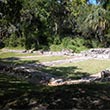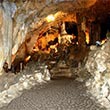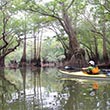|

Remains of a Spanish bombproof foundation at San Marcos de Apalache Historic State Park.
|
International Archaeology Day celebrates the thrill of discovery through archaeological excavations and insights into the past. The day was first celebrated in 2011 as National Archaeology Day and included 115 programs throughout 37 U.S. states, four Canadian provinces and an event in the United Kingdom. By 2013, the day saw 375 events worldwide, including the United States, Canada, Australia, Egypt, France, Germany, Ireland and more. Last year 75,000 people participated, resulting in a 20 percent increase from two years prior.
On Sat. Oct. 25, San Marcos de Apalache Historic State Park in St. Marks will hold an International Archaeology Day Celebration with a focus on San Marcos and Fort Ward in the Civil War Era. The event takes place from 10 a.m. to 4 p.m. and will include presentations by archaeologists, kids’ activities, pottery making and flint knapping. Local historians will speak about the impressive history of the park and Civil War Reenactors will provide Living History Demonstrations. The event is being held in conjunction with St. Marks’ Annual Stone Crab Festival and the 26th Monarch Butterfly Festival hosted by the St. Marks National Wildlife Refuge.
Florida is home to six archaeological state parks and sites, each offering a step back into Florida’s history. Crystal River Archaeological State Park in Crystal River is a six-mound complex containing burial mounds, temple and platform mounds, a plaza area and a substantial midden. For 1,600 years the site served as an imposing ceremonial center for as many as 7,500 Native Americans. Located in Northwest Florida in Tallahassee, Lake Jackson Mounds Archaeological State Park encompasses four earthen temple mounds. More than eight centuries ago, Native Americans inhabited the area in a village which served as a cultural, religious and population center. Closely situated near the Lake Jackson mounds, Letchworth-Love Mounds Archaeological State Park houses Florida’s tallest Native American ceremonial mound. At an astounding 46 feet in height, the mound is believed to have been built by members of the Weeden Island Culture 1,100 to 1,800 years ago.
Located in Palmetto, the Madira Bickel Mound State Archaeological Site was the first site in Florida to be designated as a State Archaeological Site. The 20-foot-tall, flat-topped, ceremonial mound was donated by Karl and Madira Bickel in 1948 and is composed of sand, shell and village debris. Archaeological excavations have discovered three periods of Native American cultures dating back to 2,000 years ago. Further south in Estero, Mound Key Archaeological State Park is believed to have been the ceremonial center for the Calusa Indians. Framed in forests of mangrove trees, the shell mounds and ridges of Mound Key rise more than 30 feet above the waters of Estero. Deep in the heart of the Florida Keys in Islamorada, San Pedro Underwater Archaeological Preserve State Park features a submerged shipwreck from a Spanish flotilla. The San Pedro was a 287-ton, Dutch-built ship, which sank in a hurricane in 1733. After major salvage efforts in the 1960s, the San Pedro has been left as a large pile of ballast stones upon the ocean floor.
|





